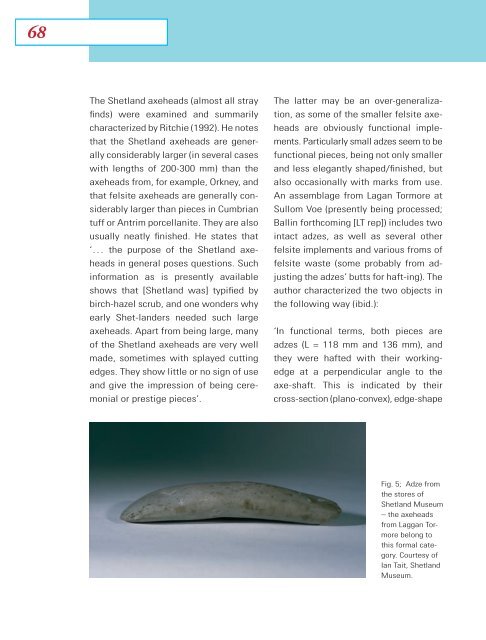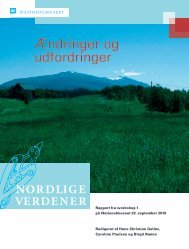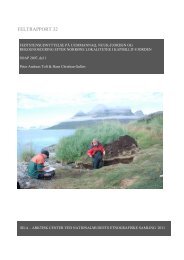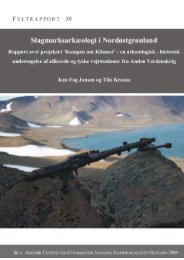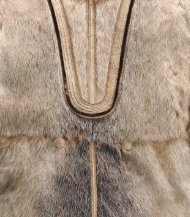The Border of Farming and the Cultural Markers - Nordlige Verdener
The Border of Farming and the Cultural Markers - Nordlige Verdener
The Border of Farming and the Cultural Markers - Nordlige Verdener
You also want an ePaper? Increase the reach of your titles
YUMPU automatically turns print PDFs into web optimized ePapers that Google loves.
68<br />
<strong>The</strong> Shetl<strong>and</strong> axeheads (almost all stray<br />
finds) were examined <strong>and</strong> summarily<br />
characterized by Ritchie (1992). He notes<br />
that <strong>the</strong> Shetl<strong>and</strong> axeheads are generally<br />
considerably larger (in several cases<br />
with lengths <strong>of</strong> 200-300 mm) than <strong>the</strong><br />
axeheads from, for example, Orkney, <strong>and</strong><br />
that felsite axeheads are generally considerably<br />
larger than pieces in Cumbrian<br />
tuff or Antrim porcellanite. <strong>The</strong>y are also<br />
usually neatly finished. He states that<br />
‘… <strong>the</strong> purpose <strong>of</strong> <strong>the</strong> Shetl<strong>and</strong> axeheads<br />
in general poses questions. Such<br />
information as is presently available<br />
shows that [Shetl<strong>and</strong> was] typified by<br />
birch-hazel scrub, <strong>and</strong> one wonders why<br />
early Shet-l<strong>and</strong>ers needed such large<br />
axeheads. Apart from being large, many<br />
<strong>of</strong> <strong>the</strong> Shetl<strong>and</strong> axeheads are very well<br />
made, sometimes with splayed cutting<br />
edges. <strong>The</strong>y show little or no sign <strong>of</strong> use<br />
<strong>and</strong> give <strong>the</strong> impression <strong>of</strong> being ceremonial<br />
or prestige pieces’.<br />
<strong>The</strong> latter may be an over-generalization,<br />
as some <strong>of</strong> <strong>the</strong> smaller felsite axeheads<br />
are obviously functional implements.<br />
Particularly small adzes seem to be<br />
functional pieces, being not only smaller<br />
<strong>and</strong> less elegantly shaped/finished, but<br />
also occasionally with marks from use.<br />
An assemblage from Lagan Tormore at<br />
Sullom Voe (presently being processed;<br />
Ballin forthcoming [LT rep]) includes two<br />
intact adzes, as well as several o<strong>the</strong>r<br />
felsite implements <strong>and</strong> various froms <strong>of</strong><br />
felsite waste (some probably from adjusting<br />
<strong>the</strong> adzes’ butts for haft-ing). <strong>The</strong><br />
author characterized <strong>the</strong> two objects in<br />
<strong>the</strong> following way (ibid.):<br />
‘In functional terms, both pieces are<br />
adzes (L = 118 mm <strong>and</strong> 136 mm), <strong>and</strong><br />
<strong>the</strong>y were hafted with <strong>the</strong>ir workingedge<br />
at a perpendicular angle to <strong>the</strong><br />
axe-shaft. This is indicated by <strong>the</strong>ir<br />
cross-section (plano-convex), edge-shape<br />
Fig. 5; Adze from<br />
<strong>the</strong> stores <strong>of</strong><br />
Shetl<strong>and</strong> Museum<br />
– <strong>the</strong> axeheads<br />
from Laggan Tormore<br />
belong to<br />
this formal category.<br />
Courtesy <strong>of</strong><br />
Ian Tait, Shetl<strong>and</strong><br />
Museum.


